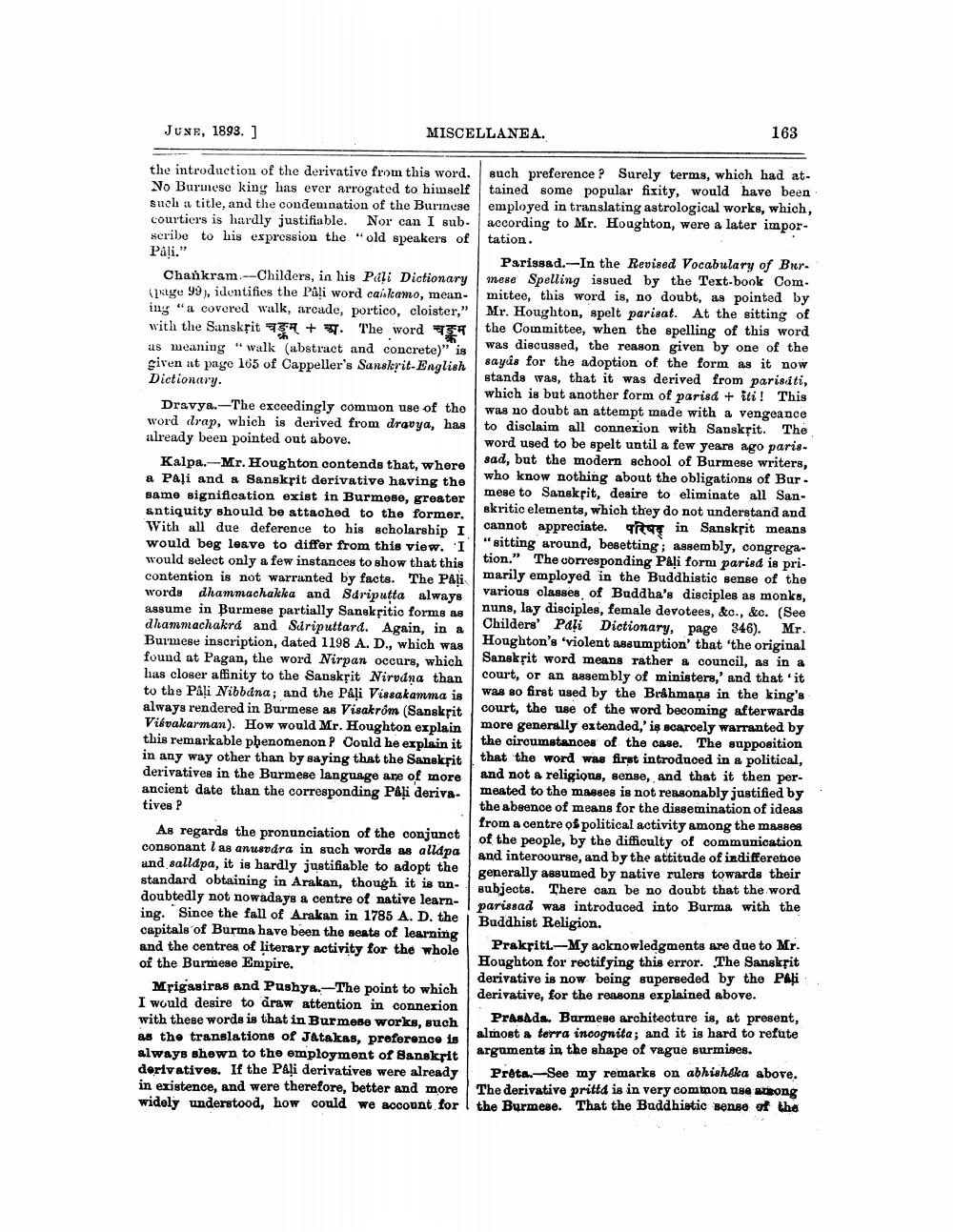________________
JUNE, 1893. ]
MISCELLANEA.
163
Pali."
the introduction of the derivative from this word. such preference? Surely terms, which had atNo Burmese king has ever arrogated to himself tained some popular fixity, would have been such a title, and the condemnation of the Burinese employed in translating astrological works, which, courtiers is hardly justifiable. Nor can I sub according to Mr. Houghton, were a later imporscribe to his espression the "old speakers of tation.
Parissad.-In the Revised Vocabulary of BurChankram Childers, in his Pati Dictionary mese Spelling issued by the Text-book Com. Ukrye 99), identifies the Pali word caiskamo, meun- mittee, this word is, no doubt, ae pointed by iny "a covered walk, arcade, portico, cloister," Mr. Houghton, spelt parisat. At the sitting of with the Sansksit 134 + . The word 796 the Committee, when the spelling of this word as meaning "walk (abstract and concrete)" is
was discussed, the reason given by one of the given at page 165 of Cappeller's Sanskrit- English
sayús for the adoption of the form as it now Dictionary.
stands was, that it was derived from parisati,
which is but another form of parisd + iti! This Dravya.-The exceedingly common use of the was no doubt an attempt made with a vengeance word drap, which is derived from dravya, has to disclaim all connexion with Sanskrit. The already been pointed out above.
word used to be spelt until a few years ago parisKalpa. Mr. Houghton contends that, where
sad, but the modern school of Burmese writers, a Pali and a Sanskrit derivative having the
who know nothing about the obligations of Bur. samo signification exist in Burmese, greater
mese to Sanskrit, desire to eliminate all Sanantiquity should be attached to the former,
skritio elements, which they do not understand and With all due deference to his scholarship I
cannot appreciate. in Sanskrit means would beg lesve to differ from this view. I "sitting around, besetting assembly, congregawould select only a few instances to show that this
tion." The corresponding PAļi form parisd is pricontention is not warranted by facts. The PAļi
marily employed in the Buddhistic sense of the words dhammachakka and Sariputta always
various classes of Buddha's disciples as monks, assume in Burmese partially Sanskritio forms as
nuns, lay disciples, female devotees, &c., &o. (See dhammachakra and Suriputtard. Again, in a
Childers' Pali Dictionary, page 346). Mr. Burmese inscription, dated 1198 A. D., which was
Houghton's 'violent assumption' that 'the original found at Pagan, the word Nirpan occurs, which
Sanskrit word means rather & council, as in a has closer affinity to the Sanskrit Nirudna than
court, or an assembly of ministers,' and that it to the Påļi Nibbdna; and the Paļi Vissakamma is
was so first used by the Brahmans in the king's always rendered in Burmese as Visakróm (Sanskrit court, the use of the word becoming afterwards Vibvakarman). How would Mr. Houghton explain more generally extended,' is scarcely warranted by this remarkable phenomenon P Could he explain it the circumstances of the case. The supposition in any way other than by saying that the Sanskrit that the word was first introduced in & political, derivatives in the Burmese language are of more and not a religions, sense, and that it then perancient date than the corresponding Pați deriva- meated to the masses is not reasonably justified by tives P
the absence of means for the dissemination of ideas
from a centre of political activity among the masses As regards the pronunciation of the conjunct
of the people, by the difficulty of communication consonant l as anusvara in such words as alldpa
and interoourse, and by the attitude of indifference and salldpa, it is hardly justifiable to adopt the
generally assumed by native rulers towards their standard obtaining in Arakan, though it is un.
subjects. There can be no doubt that the word doubtedly not nowadays a centre of native learn
parissad was introduced into Burma with the ing. Since the fall of Arakan in 1785 A. D. the
Buddhist Religion. capitals of Burma have been the seats of learning and the centres of literary activity for the whole
Prakriti.-My acknowledgments are due to Mr. of the Burmese Empire.
Houghton for rectifying this error. The Sanskrit
derivative is now being superseded by tho Papi Mrigasiras and Pushya.-The point to which
derivative, for the reasons explained above. I would desire to draw attention in connexion with these words is that in Burmese works, such
Prasada. Burmese architecture is, at present, 85 the translations of JAtakas, preference is almost a terra incognita, and it is hard to refute always shown to the employment of Banskrit arguments in the shape of vague Burmises. derivatives. If the Paļi derivatives were already | Preta.-See my remarks on abhisheka above. in existence, and were therefore, better and more The derivative prittd is in very common use strong widely understood, how could we account for the Burmese. That the Buddhistic sense of the




